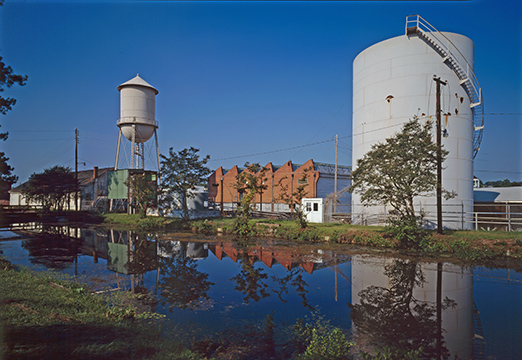
If you are looking to make something, or make a life, and would like a support system to ensure you are successful, then you would be foolhardy not to consider South Carolina. Perhaps you have only been to the state’s beaches or mountains, or traveled on I-95. If that’s the case, you are missing many of the interesting things about the Palmetto State.
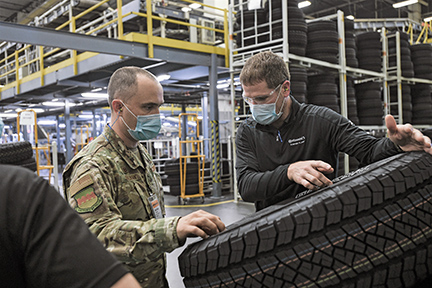 For those still worried that our country doesn’t make things, take a drive through South Carolina. There are many businesses visible from the highway, and many more tucked away out of sight. There are probably South Carolinians that don’t know all the products being made there. Over 6,000 manufacturers run the gamut of producing everything from textiles, tires, cars, planes and buses to state-of-the-art medical devices, robots, piezoelectric sensors and military equipment. As Kevin Landmesser, Senior Vice President of Greenville Area Development Corporation, put it, “We’re not just making things here, we’re making very complex things.”
For those still worried that our country doesn’t make things, take a drive through South Carolina. There are many businesses visible from the highway, and many more tucked away out of sight. There are probably South Carolinians that don’t know all the products being made there. Over 6,000 manufacturers run the gamut of producing everything from textiles, tires, cars, planes and buses to state-of-the-art medical devices, robots, piezoelectric sensors and military equipment. As Kevin Landmesser, Senior Vice President of Greenville Area Development Corporation, put it, “We’re not just making things here, we’re making very complex things.”
There are hundreds of food and beverage companies, with new ones arriving frequently. Keurig Dr. Pepper has both a headquarters and manufacturing plant outside of Spartanburg. Whiteclaw Hard Seltzer and Mike’s Hard Lemonade are located near the state’s capitol in Columbia. Sumter is home to one of the world’s oldest and largest squab producers (a bird considered a delicacy) that boasts, “Our squab has been served on plates of kings and queens, presidents, prime ministers, dignitaries and other lovers of great food because of the quality they demand.”
The state has been announcing deals for all kinds of new companies at a rapid pace. In the last two months prior to this writing, there have been 20 announcements, and in the last two years during the pandemic, 279 companies decided to relocate or expand there, creating over 29,000 new jobs.
Clearly, word of South Carolina’s ecosystem for success is spreading. . .not surprising considering they have been developing and honing it for well over two centuries. And thanks to savvy businessmen and politicians, the state has for a long time garnered investment.
In the 1800s, some of the country’s most extensive rail lines ran throughout the state, thanks to the enormous amount of cotton grown and exported as a raw commodity.
In the mid-1800s, South Carolina became home to the first large industrialized mill in the South, one that could turn locally grown cotton into finished product and allow the financial gains from making textiles to remain in the state. This pinnacle move began to change the economy from merely agrarian to a hybrid that included manufacturing.
Graniteville Mill, built in 1849 in what is now Aiken County, initially employed 400 (as paid labor, its founder eschewed the norm of using slave labor) and later grew to over 2,700. The business was so successful it enticed others to build mills throughout the state that were large enough to produce goods for local consumption and exportation. You can still see their influence in the cities and towns. Many of the brick buildings like Graniteville Mill have been renovated and turned into sought-after real estate for residential, retail and commercial offices. They offer quaint charm and anchors for local economies, much as they did back when they were built.
The world recognizes the charm of Charleston. . .for years it’s held the top spot on Condé Nast’s list of best small cities in the U.S. But thanks at least in part to these old mills, similar charms exist in the inland towns and cities.
Church bells toll melodically every quarter hour in Sumter. There are still streets left unpaved in Aiken for its large equestrian population. (Aiken is a premiere events and training site and the U.S. polo capital. . .horses have the right-of-way downtown.) There are thriving local shops in Cheraw, Florence and Clinton; numerous must-see botanical gardens like Kalmia in Hartsville or Brookgreen in Murrells Inlet, to name a few, and plenty of community events including symphony performances, food truck rodeos, rock concerts and art shows. The state begs exploration.
But more than just a vacation destination, these places offer the opportunity to build a life. They are friendly and welcoming and embrace those looking to become part of something in their state. As Lewis Brown, Economic Development Director for Darlington County EDP, said, “We are so friendly here, if you can’t make friends in South Carolina it’s probably your fault.”
Rankings and statistics back up this notion. Greenville was voted most friendly city in the U.S. in 2021, and the state has seen record growth for inbound moves, consistently ranking among the top five and grabbing third place last year.
There is a long history of welcoming outsiders. Certainly the 15 military bases located around the state contribute to this culture, but perhaps more pertinent is what happened when the textile industry started to decline in the 1960s. . .another dip in what had been a long roller coaster ride for the industry. State leaders from the public and private sectors came together to attract foreign direct investment (FDI). With this leadership came two significant developments.
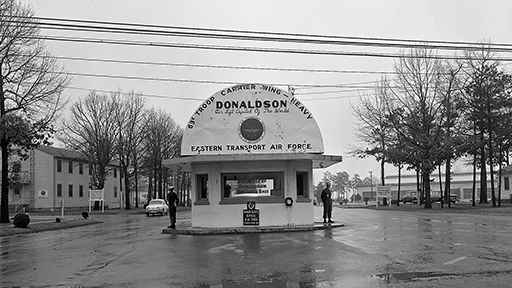 With FDI specifically in mind, the state, Greenville County, the City of Greenville and private sector leaders worked to obtain title to the decommissioned Donaldson Air Force Base and turn it into an industrial park to entice new business. Renamed the Donaldson Center Industrial Airpark in 1964, the property provided a place with ready infrastructure, large empty buildings and plenty of acreage. The novel center was a grand success, landing North America’s first Michelin tire plant, which has continued to expand in the state and is most probably responsible for bringing Bridgestone Americas to the old Graniteville Mill site in 1984 after it had been shuttered. Just as that first textile plant’s success enticed others, tire makers have flocked to South Carolina, making it the largest tire producer in North America.
With FDI specifically in mind, the state, Greenville County, the City of Greenville and private sector leaders worked to obtain title to the decommissioned Donaldson Air Force Base and turn it into an industrial park to entice new business. Renamed the Donaldson Center Industrial Airpark in 1964, the property provided a place with ready infrastructure, large empty buildings and plenty of acreage. The novel center was a grand success, landing North America’s first Michelin tire plant, which has continued to expand in the state and is most probably responsible for bringing Bridgestone Americas to the old Graniteville Mill site in 1984 after it had been shuttered. Just as that first textile plant’s success enticed others, tire makers have flocked to South Carolina, making it the largest tire producer in North America.
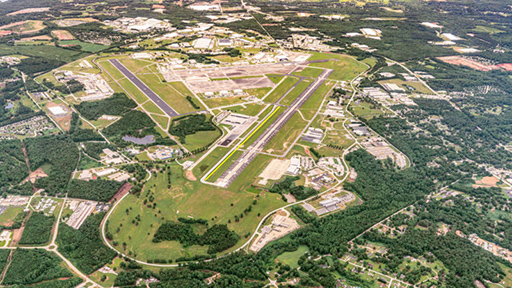 Greenville’s industrial airpark, now called the South Carolina Technology & Aviation Center (SCTAC), is a 2,600-acre property that has grown increasingly more sophisticated. Complete with its own large aircraft landing strip and the nation’s only publicly owned automotive testing track, SCTAC is a microcosm of the state’s economy, housing businesses for the private and public sector. It supports over 6,800 jobs in 110 companies representing automotive, aerospace, military and advanced manufacturing, which contribute $2 billion to the state’s economy.
Greenville’s industrial airpark, now called the South Carolina Technology & Aviation Center (SCTAC), is a 2,600-acre property that has grown increasingly more sophisticated. Complete with its own large aircraft landing strip and the nation’s only publicly owned automotive testing track, SCTAC is a microcosm of the state’s economy, housing businesses for the private and public sector. It supports over 6,800 jobs in 110 companies representing automotive, aerospace, military and advanced manufacturing, which contribute $2 billion to the state’s economy.
Lockheed Martin, located at SCTAC since 1984, provides both production and maintenance/modification services for military and civilian aircraft, and it officially began production of the world’s most advanced F-16 fighter jets in 2019.
Business parks are one key ingredient to South Carolina’s success that arose from the pivot in 1960s; another is the tech college system, which many credit to Ernest F. (Fritz) Hollings.
Hollings was elected governor in 1959, and U.S. senator in 1968, serving alongside Strom Thurman for a record-breaking 36 years. The duo gave South Carolina clout in national politics well beyond its relatively small population. Hollings and Thurman were able to craft legislation and projects that benefited their state — the highway system, water systems, aviation and seaport facilities, coastal research and conservation, as well as the bolstering of infrastructure, which continue to contribute to the state’s success.
A true statesman, Hollings believed in the importance of education and economic development and once declared, “Today, in our complex society, education is the cornerstone upon which economic development must be built – and prosperity assured.”
Determined to create jobs and build a skilled industrial workforce, Hollings set forth a vision for a statewide network of low-tuition, technical schools. His plan was passed by the legislature in 1961. The SC Technical College System has 16 campuses offering 78 degrees, 28 diplomas and 1,000 certificate programs. Free tuition is available for certain high-demand jobs. If you haven’t seen what they offer, it’s worth a look at their website, sctechsystem.edu. . .you might be surprised.
The offerings are many and widely varied, including arts, science, medical, accounting, engineering and even writing. And those quaint small towns and bustling cities all have access to this higher education system. The campuses were strategically placed so that nearly every South Carolinian is within a 30-minute drive from one of the main or satellite campuses.
The state is home to 61 colleges, including eight historically Black. If not familiar with the academic offerings, you may have heard about the famous rivalry between the University of South Carolina Gamecocks, located in Columbia, and Clemson University Tigers, located 125 miles to the west in their namesake town. Aside from sports, each is renowned by the world for their research and doctoral programs. USC is classified as an R1 Doctoral University with some of the world’s highest levels of research activity.
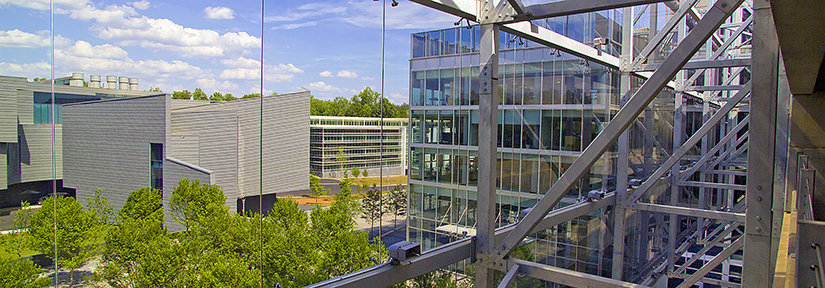 Clemson University is famous for its CU-ICAR, short for Clemson University International Center for Automotive Research. It has the nation’s only Graduate Department of Automotive Engineering where students can obtain Master of Science and/or Ph.D. degrees in Automotive Engineering. During the writing of this article, the United States Army DEVCOM Ground Vehicle Systems Center, which is partnered with Clemson, announced a $22 million investment aimed at developing innovative virtual prototyping tools for designing the next generation of on- and off-road vehicles. This is in addition to the $18 million announced in 2021, and only part of the $100 million the U.S. government has pledged to commit.
Clemson University is famous for its CU-ICAR, short for Clemson University International Center for Automotive Research. It has the nation’s only Graduate Department of Automotive Engineering where students can obtain Master of Science and/or Ph.D. degrees in Automotive Engineering. During the writing of this article, the United States Army DEVCOM Ground Vehicle Systems Center, which is partnered with Clemson, announced a $22 million investment aimed at developing innovative virtual prototyping tools for designing the next generation of on- and off-road vehicles. This is in addition to the $18 million announced in 2021, and only part of the $100 million the U.S. government has pledged to commit.
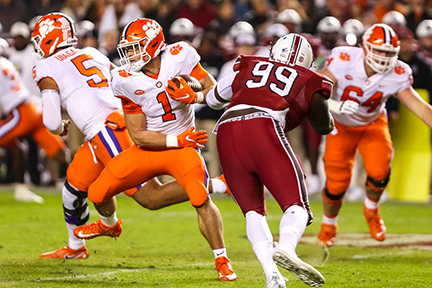 While the two may compete ferociously in athletics, like so many entities in South Carolina, they team up to help their state when it comes to the economy. Allied with the Medical University of South Carolina, which is also highly regarded for its research, the three use state lottery funds to create Centers of Economic Excellence in research areas that will advance South Carolina’s economy.
While the two may compete ferociously in athletics, like so many entities in South Carolina, they team up to help their state when it comes to the economy. Allied with the Medical University of South Carolina, which is also highly regarded for its research, the three use state lottery funds to create Centers of Economic Excellence in research areas that will advance South Carolina’s economy.
Today there are nearly 51 Smart State Centers in six industry-focused Smart Clusters that are critical to South Carolina and the world: Advanced Materials and Nanotechnology, Automotive and Transportation, Biomedical, Energy and Alternative Fuels, Information Science, and Pharmaceutical. Each Center is awarded $2 million to $5 million in state lottery funds, which must be matched on a dollar-for-dollar basis with non-state funds from corporations or other entities. The program also supports SmartState Endowed Chairs, world-renowned scientists and engineers who lead the Centers. By investing in talent and technology, the SmartState Program is fueling the state’s knowledge economy and creating high-paying jobs and an improved standard of living in South Carolina. In just 10 years, the SmartState Program has attracted more than $1.5 billion in non-state investment, has led to the creation of more than 10,000 jobs, and has assembled a who’s who of corporate partners, including BMW, Fluor, Michelin and Boeing.
One could say that economic development teams resemble the Tigers and Gamecocks. They compete fiercely with one another until they see where it makes sense for a project to land. Chuck Whipple, Executive Director of MTC Enterprise Campus, said, “Once the local developer sees the area(s) a project is targeting, we stop competing and work together to make the project a reality for the region.”
Speaking about what the state offers once a company has landed, Alex Clark, Media Director for the South Carolina Department of Commerce, said, “You don’t just get the wedding here. You get the family you married into and all the support they offer.”
Everyone interviewed for this article agreed that the Palmetto State’s most powerful tools are pulling together as a team, and building bridges between learning and working. The world has always begged for new ways of doing things and South Carolina keeps delivering.
Jody Bryson, President and CEO of SCTAC, said about these tools, “In South Carolina, partnerships are part of our DNA. When a project needs a creative solution, or a company needs to expand its operations, using our colleges and universities to help innovate just makes sense. The first question we ask is, ‘How do we connect that next bridge between education and business, and what’s the best team we can put together to expedite it quickly?’ ”
An invaluable member of many teams is readySC, which is the workforce training division of the SC Tech College system, and has offices located on each of the main campuses. ReadySC is also one of the nation’s oldest and most experienced workforce training programs. . .it celebrated its 60th anniversary in 2021. ReadySC offers companies the gift of a team to manage all aspects of developing a workforce. They essentially provide customized recruitment and training solutions for all types of businesses, which could otherwise be costly. In South Carolina all these services are available for minimal cost or free.
Providing free or low-cost space to soften the landing for new or expanding businesses in the state is another effective tool for success that South Carolina offers in a variety of ways.
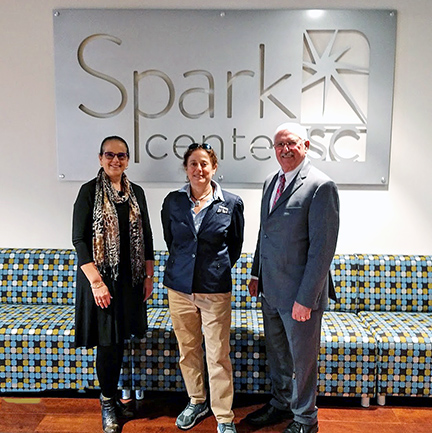 Foreign and domestic companies looking to start and locate in Spartanburg County can find a powerful ally in The Spark Center. There are over 90,000 square feet for offices, meeting space and warehousing, as well as loading docks and a 5-ton overhead crane. There is a lot of flexibility to meet specific needs, and there are support services that come with the arrangement.
Foreign and domestic companies looking to start and locate in Spartanburg County can find a powerful ally in The Spark Center. There are over 90,000 square feet for offices, meeting space and warehousing, as well as loading docks and a 5-ton overhead crane. There is a lot of flexibility to meet specific needs, and there are support services that come with the arrangement.
Here’s what clients had to say: “The exceptional resources offered by the Spartanburg Community College’s Spark Center were key factors in making the very competitive site selection decision for Kobelco. Not only did this great facility provide an excellent ‘soft landing,’ but it also allowed Kobelco to hit the ground running into a bright and prosperous future.”
And from one of the most well-known companies to have used the center, Keurig Dr Pepper, “The Spark Center provided us a lot of resources that you would normally have to do in a construction trailer, and that doesn’t allow for a lot of collaboration with that many people. . .It was exceptionally good for us in terms of logistics. We set up a simulation of our manufacturing equipment in the Spark Center so we could start training immediately.”
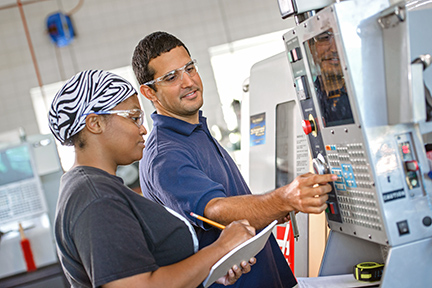 The Enterprise Campus located in Columbia is part of the Midlands Technical College, Northeast Campus. It is a 130-acre property with a Business Accelerator for smaller companies and the only Class A Industrial Park in Columbia. Accelerator and Industrial Park tenants have the opportunity to partner with the college on innovation and workforce development, which could involve internships for students.
The Enterprise Campus located in Columbia is part of the Midlands Technical College, Northeast Campus. It is a 130-acre property with a Business Accelerator for smaller companies and the only Class A Industrial Park in Columbia. Accelerator and Industrial Park tenants have the opportunity to partner with the college on innovation and workforce development, which could involve internships for students.
Their first tenant, The Ritedose Corporation, went from groundbreaking to ribbon cutting in nine short months, and said working with MTC Enterprise Campus enabled them to move quickly by getting some of the typical road blocks out of the way.
Speaking of roads and blocks, the moving of goods made in the state to foreign and domestic markets is another area in which South Carolina excels. Being located halfway between Miami and New York City makes two-thirds of the country reachable within less than two days by truck or rail, and there are ample ways to move freight by air and sea.
The South Carolina Port Authority (SC Ports) owns and operates the Port of Charleston, Port of Georgetown, Inland Port Greer and Inland Port Dillon. As a top 10 U.S. container port, SC Ports is known for efficiently run terminals, ample capacity, reliable service and customer-centric operations. SC Ports has invested more than $2 billion in port infrastructure in recent years, ensuring capacity and fluidity for the Southeast supply chain. Port operations create one in 10 South Carolina jobs and generate a $63.4 billion economic impact each year.
Longtime industry observers believe the state is just starting to tap into its air cargo potential. Brandon Fried, executive director of The Airforwarders Association, a Washington, D.C. trade group, attributes the recent cargo volume increases to South Carolina’s efforts to create an accommodating business environment. “South Carolina continues to attract automotive, technology and aircraft manufacturing interests that serve as essential ingredients to its current economic recipe for success,” Fried said.
 In 2019, Greenville-Spartanburg International Airport (GSP) opened a $33 million air cargo facility. The 110,000-square-foot cargo facility and its 17-acre apron allow the airport to accommodate up to three Boeing 747-800 freighter aircraft simultaneously, tripling the airport’s previous handling capacity. Last year saw an increase of over 48 percent from 2020, including over 43,800 tons of international freight valued at $5.01 billion, an increase in value of 14.6 percent over 2020. In 2021, GSP was ranked 21st in the nation in terms of international freight tonnage handled according to
In 2019, Greenville-Spartanburg International Airport (GSP) opened a $33 million air cargo facility. The 110,000-square-foot cargo facility and its 17-acre apron allow the airport to accommodate up to three Boeing 747-800 freighter aircraft simultaneously, tripling the airport’s previous handling capacity. Last year saw an increase of over 48 percent from 2020, including over 43,800 tons of international freight valued at $5.01 billion, an increase in value of 14.6 percent over 2020. In 2021, GSP was ranked 21st in the nation in terms of international freight tonnage handled according to
USTradeNumbers.com.
If you are getting the idea that South Carolina is all work and no play, put that notion away. The state is just as serious about having fun as it is about making things and contributing to its own and the world’s economy. This can easily be seen throughout its cities and towns. The vibrant restaurant scene found around the state offers not only world-class barbecue, but a variety of ethnic food that reflects a diverse population. Many have outdoor seating to take advantage of the temperate climate enjoyed much of the year. The music and arts scenes are robust and deep-rooted.
For those more active, the Palmetto State has over 90,000 acres of protected lands stretching from the Blue Ridge Mountains to the sand dunes of the Atlantic Ocean with plenty of lakes, streams, rivers and grasslands that provide sanctuary for wildlife and a variety of ways for people to connect with nature and each other. Whether you are into hiking, paddling, horseback riding, swimming or biking, there are plenty of choices, including every Tuesday night at SCTAC where as many as 250 cyclists take advantage of the roads that allow them to ride the flats and hills. This is just one of many such clubs one can join to exercise or find friends.
The hard work of making and selling something or finding a place in a community where you will feel valued is made much easier in South Carolina. Although this article has touched on many programs and things that support finding success, it is merely the tip of the iceberg. Just like those businesses tucked away from sight of the roadways, there are so many more. . .even South Carolinians don’t know all that is offered.